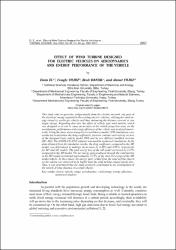| dc.contributor.author | El, Emin | |
| dc.contributor.author | Yıldız, Cengiz | |
| dc.contributor.author | Dandıl, Beşir | |
| dc.contributor.author | Yıldız, Ahmet | |
| dc.date.accessioned | 2022-11-01T06:03:13Z | |
| dc.date.available | 2022-11-01T06:03:13Z | |
| dc.date.issued | 2022 | en_US |
| dc.identifier.citation | El, E., Yildiz, C., Dandil, B., Yildiz, A. (2022). Effect of wind turbine designed for electric vehicles on aerodynamics and energy performance of the vehicle. Thermal Science, 26 (4), pp. 2907-2917.
https://doi.org/10.2298/TSCI2204907E | en_US |
| dc.identifier.uri | https://doi.org/10.2298/TSCI2204907E | |
| dc.identifier.uri | https://hdl.handle.net/20.500.12508/2180 | |
| dc.description.abstract | This study aims to generate, independently from the electric network, one part of the electrical energy required in the existing electric vehicles, utilizing the wind energy raised by on-the-go vehicles and thus enhancing the distance covered at one single charge. Regarding that aim, the effect of vehicle type wind turbine, which was designed so as not to cause an increase in the vehicle projection area, on the aerodynamic performance and energy efficiency of the vehicle was analyzed numerically. Using the shear stress transport k-ω turbulence model, CFD simulations were conducted to determine the drag coefficients, pressure contours and velocity vectors of the designed basic vehicle model (M0) and its two different modified versions (M1, M2). The ANSYS-FLUENT software was used for numerical simulations. In the data obtained from the simulation results, the drag coefficient, compared to the M0 model, was determined to undergo an increase by 8.49% and 4.05%, respectively for M1 and M2 models. The total energy loss of the M2 model increased by 2.47% compared to the M0 model. The net energy gain produced through the wind turbine in the M2 model constituted approximately 5.13% of the total lost energy of the M0 model vehicle. In this context, the energy gain yielded from the wind turbine placed on the vehicle was observed to be higher than the wind turbine-caused energy loss. Thus, it was determined that the study positively contributed to the prolongation of the vehicle driving distance on a single charge | en_US |
| dc.language.iso | eng | en_US |
| dc.publisher | Serbian Society of Heat Transfer Engineers | en_US |
| dc.relation.isversionof | 10.2298/TSCI2204907E | en_US |
| dc.rights | info:eu-repo/semantics/openAccess | en_US |
| dc.subject | Aerodynamic | en_US |
| dc.subject | Electric vehicle | en_US |
| dc.subject | Energy efficiency | en_US |
| dc.subject | Numerical analysis | en_US |
| dc.subject | Range | en_US |
| dc.subject | Wind energy | en_US |
| dc.subject.classification | Aerodynamic Drag | |
| dc.subject.classification | Computational Fluid Dynamics | |
| dc.subject.classification | Wind Tunnels | |
| dc.subject.classification | 4 Electrical Engineering, Electronics & Computer Science
4.18 Power Systems & Electric Vehicles
4.18.788 Electric Vehicles | |
| dc.subject.classification | Thermodynamics | |
| dc.subject.other | System | |
| dc.title | Effect of wind turbine designed for electric vehicles on aerodynamics and energy performance of the vehicle | en_US |
| dc.type | article | en_US |
| dc.relation.journal | Thermal Science | en_US |
| dc.contributor.department | Mühendislik ve Doğa Bilimleri Fakültesi -- Mekatronik Mühendisliği Bölümü | en_US |
| dc.identifier.volume | 26 | en_US |
| dc.identifier.issue | 4 | en_US |
| dc.identifier.startpage | 2907 | en_US |
| dc.identifier.endpage | 2917 | en_US |
| dc.relation.publicationcategory | Makale - Uluslararası Hakemli Dergi - Kurum Öğretim Elemanı | en_US |
| dc.contributor.isteauthor | Dandıl, Beşir | |
| dc.relation.index | Web of Science - Scopus | en_US |
| dc.relation.index | Web of Science Core Collection - Science Citation Index Expanded | |
















